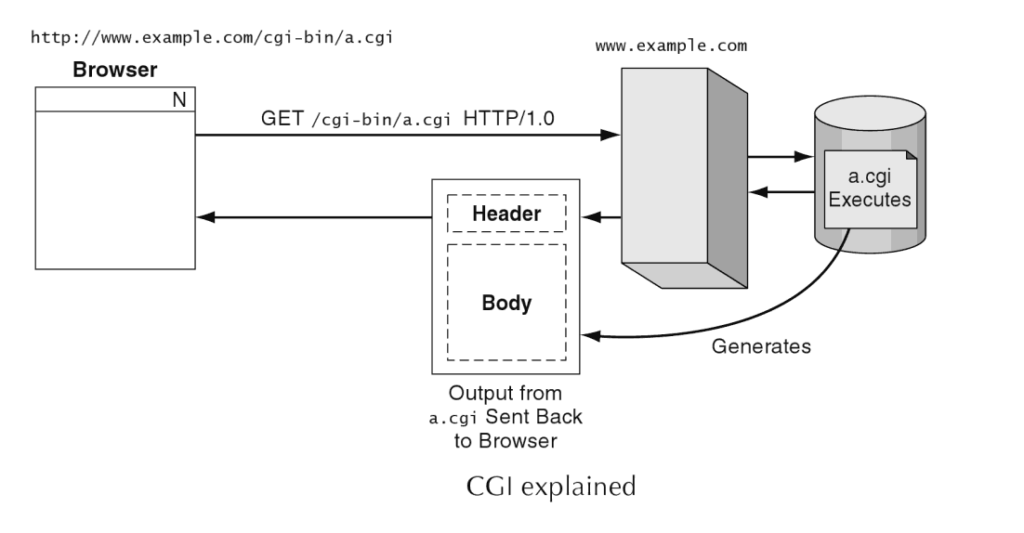What is the Common Gateway Interface
CGI, or Common Gateway Interface, is a protocol for exchanging data between a client and a server. CGI scripts may be created in almost any programming language.
A CGI script is a programme written in any language that uses this standard to transmit data between a Web server and the client’s browser. A CGI script is software that acts as an external gateway between information servers such as HTTP or Web servers and client browsers.
CGI scripts are significant because they allow the web servers to be dynamic and interactive with the client browser as the server receives and accepts user inputs and responds to them in a measured and relevant way to satisfy the user. Without CGI, the information the users would get from an information server would not be packaged based on the request but based on how it is stored on the server.
Both CGI programs or scripts, when executed at the information server, help organise information for both the server and the client. For example, the server may want to retrieve information entered by the visitors and use it to package a suitable output for the clients. In addition, GCI may be used to set field descriptions on a form and in real-time dynamically inform the user on what data has been entered and yet to be entered.
Origins of CGI
CGI emerged in the early days of the internet as a means to facilitate dynamism in web pages. Initially, static HTML documents constituted the majority of web content, lacking the ability to deliver personalized experiences to users. CGI bridged this gap by providing a mechanism for web servers and external programs to communicate, enabling dynamic content generation.
How CGI Works
CGI operates through a client-server interaction model, with the web server acting as the intermediary. When a user interacts with a web page that relies on CGI, the web server passes the user’s request to a specified CGI program, which processes the request and generates dynamic content. This content is then returned to the web server, which delivers it to the user’s browser for display.
Key components in the CGI process include the web server, web browser, and CGI program. The web server receives the user’s request, identifies the associated CGI program, and sends the request data to the program. The CGI program processes the request, generating dynamic content based on the specified logic and any user-provided data. Finally, the web server sends the generated content back to the user’s browser for rendering.
Common Uses of CGI
CGI finds extensive application in various aspects of web development, offering functionalities that contribute to enhanced user experiences and interactivity. Some common uses of CGI include the following:
Dynamic content generation:
One of the primary purposes of CGI is to empower websites to produce personalized and dynamic content in response to user actions or preferences. By leveraging CGI programming, web developers can create web pages that display content tailored to individual users, leading to an engaging and customized browsing experience.
Form processing:
CGI also plays a vital role in handling user inputs via forms on websites. When users submit data through an HTML form, CGI scripts can process and validate that data in real-time. This enables websites to respond to user input, apply appropriate actions, and store form submissions for future use.
Database integration:
By linking CGI programs with databases, web developers can create powerful and interactive web applications. CGI can retrieve data from databases, present it to users, and allow them to interact with and modify that data. This enables the creation of dynamic web pages that display real-time information and provide efficient data management capabilities.
Security considerations in CGI implementations:
When working with CGI, it is crucial to address security considerations to protect sensitive user data and maintain the integrity of the website. Implementing secure practices, such as input validation and protecting against malicious code execution, ensures a safe browsing experience for users and safeguards against potential threats.
Explanation of CGI
As shown in the image below, what happens during the request and execution of a CGI request. A CGI request is recognised by the web server by the location of the thing requested or by the file name extension. For example, if you load the URL www.example.com/cgi-bin/a.cgi into the browser, the webserver contacted www.example.com receives a request such as the following:
GET /cgi-bin/a.cgi HTTP/1.0
The server notices that the directory that contains the thing requested is cgi-bin. It is configured to take the object requested, which is here a.cgi that is a program located on the server and execute it as a standalone program.

The program generates standard output (in Perl, we would use print ( )). This output is in an important format, a header, a blank line and the body.
Conclusion
CGI remains an important component of web development, driving the creation of dynamic and interactive web experiences. Understanding the role and functionality of CGI empowers developers to make informed decisions when implementing web applications. While newer alternatives have emerged, CGI continues to serve its purpose, with developers maintaining its relevance alongside more recent technologies. By harnessing the power of CGI or exploring its alternatives, web developers can unlock the potential to create seamless and engaging user experiences.